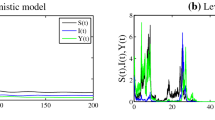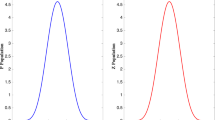Abstract
The formalism and results of the theory of random evolutions are used to establish and investigate a model for two randomly interacting populations. The asymptotic stability of the expected solution is studied and contrasted to that of the associated deterministic system.
Similar content being viewed by others
Literature
Abramowitz, M. and I. A. Stegun. 1965. (Eds).Handbook of Mathematical Functions. New York: Dover.
Bartlett, M. S. 1960.Stochastic Models in Ecology and Epidemiology. London: Methuen.
Bécus, G. A. 1979. “Stochastic Prey-Predator Relationships: A Random Differential Equation Approach.”Bull. Math. Biol,41, 91–100.
Bharucha-Reid, A. T. 1960.Elements of the Theory of Markov Processes and their Applications. New York: McGraw-Hill.
Coppel, W. A. 1965.Stability and Asymptotic Behavior of Differential Equations. Boston: Heath.
Gard, T. C. and D. Kannan. 1976. “On a Stochastic Differential Equation Modeling Prey-Predator Evolution.”J. Appl. Prob.,13, 429–443.
Goel, N. S., S. C. Maitra and E. W. Montroll. 1971. “On the Volterra and Other Nonlinear Models of Interacting Populations.”Rev. Mod. Phys. 43, 321–376.
—, and N. R. Dyn. 1974.Stochastic Models in Biology. New York: Academic Press.
Gomatam, J. 1974. “A New Model of Interacting Populations—I: Two Species Systems.”Bull. Math. Biol.,36, 347–353.
Griego, R. and R. Hersh. 1971. “Theory of Random Evolutions with Applications to Partial Differential Equations.”TAMS,156, 405–418.
Hersh, R. and M. Pinsky. 1972. “Random Evolutions are Asymptotically Gaussian.”Comm. Pure Appl. Math. 25, 33–44.
Kannan, D. 1976. “On Some Markov Models of Certain Interacting Populations.”Bull. Math. Biol.,38, 723–738.
Kurtz, T. G. 1972. “A Random Trotter Product Formula.”Proc. AMS 35, 147–154.
— 1973. “A Limit Theorem for Perturbed Operator Semigroups with Applications to Random Evolutions.”J. Funct. Anal. 12, 55–67.
Lions, J. L. 1976.Sur Quelques Questions d'Analyse, de Mécanique, et de Contrôle Optimal. Montréal, Canada: Presses de l'U. de Montréal.
Prajneshu, 1976a. “A Stochastic Model for Two Interacting Species.”Stoch. Proc. Appl. 4, 271–282.
Prajneshu, 1976b. “Two-Species Systems in Random Environment.” To appear.
Soong, T. T. 1973.Random Differential Equations in Science and Engineering. New York: Academic Press.
Author information
Authors and Affiliations
Rights and permissions
About this article
Cite this article
Bécus, G.A. Stochastic prey-predator relationships: A random evolution approach. Bltn Mathcal Biology 41, 543–554 (1979). https://doi.org/10.1007/BF02458329
Received:
Revised:
Issue Date:
DOI: https://doi.org/10.1007/BF02458329




